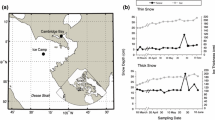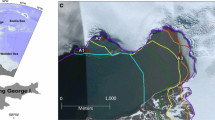Abstract
Lake Baikal freezes for 4–5 months each year; yet the planktonic diatoms that grow under the ice include some of the largest species found in freshwater. An important factor influencing their growth is the depth of snow. In this study, a population of Aulacoseira baicalensis developed where there was little or no snow on the ice but declined where there was 10 cm of snow, because 99% of the available light was attenuated. Culture studies of light response showed that A. baicalensis was adapted to relatively low light intensities (<40 μmol m−2 s−1) that were close to the average that a cell experiences in L. Baikal when mixed vertically by convection to depths that can exceed 100 m. On sunny days, cell division could be inhibited down to >10 m depth but narrow (<15 μm) diameter cells trapped in high light intensities in sub-ice layers switched to auxosporulation and size regeneration.




Similar content being viewed by others
References
Bidoshvili YeD, Bondarenko NA, Sakirko MV, Khanayev IV, Likhoshway YeV (2007) The change in the length of colonies of the planktonic diatom Aulacoseira baicalensis in various stages of the annual cycle in Lake Baikal. Hydrobiol J 43:79–86
Bondarenko NA, Timoshkin OA, Ropstorf P, Melnik NG (2006) The under-ice and bottom periods in the life cycle of Aulacoseira baicalensis (K. Meter) Simonsen, a principal Lake Baikal alga. Hydrobiol J 568:107–109
Cronberg G, Gelin C, Larsson K (1975) Lake Trummmen restoration project. II. Bacteria, phytoplankton and phytoplankton productivity. Verh Int Ver Limnol 19:1088–1096
Fietz S, Kobanova G, Izmest’eva L, Nicklisch A (2005) Regional, vertical and seasonal distribution of phytoplankton and photosynthetic pigments in Lake Baikal. J Plankton Res 27:793–810
Grachev MA, Vorobyova SS, Likhoshway YV, Goldberg EL, Ziborova GA, Levina OL, Khlystov OL (1998) A high-resolution diatom record of the palaeoclimates of East Siberia for the last 2.5 My from Lake Baikal. Quart Sc Rev 17:1101–1106
Granin NG, Jewson D, RYu Gnatovsky, Levin LA, Zhdanov AA, Averin AI, Gorbunova LA, Tsekhanovskii VV, Doroschenko LF, NYu Mogilev (1999) Turbulent mixing in the water layer just below the ice and its role in development of diatomic algae in Lake Baikal. Dokl Akad Nauk 366:835–839
Granin NG, Jewson D, RYu Gnatovsky, Levin LA, Zhdanov AA, Averin AI, Gorbunova LA, Tsekhanovskii VV, Doroschenko LF, Minko NP, Grachev MA (2000) Turbulent mixing under ice and the growth of diatoms in Lake Baikal. Verh Int Ver Limnol 27:2812–2814
Gutt J (1995) The occurrence of sub-ice algal aggregations off northeast Greenland. Polar Biol 15:247–252
Jewson D (1975) The relation of incident radiation to diurnal rates of photosynthesis in Lough Neagh. Int Rev ges Hydrobiol 60:759–767
Jewson DH, Wood RB (1975) Some effects on integral photosynthesis of artificial circulation of phytoplankton through light gradients. Verh Int Ver Limnol 19:1037–1044
Jewson DH, Granin NG, Zhdarnov AA, Gorbunova LA, Bondarenko NA, Gnatovsky RYu (2008) Resting stages and ecology of the planktonic diatom Aulacoseira skvortzowii in Lake Baikal. Limnol Oceanogr 53:1125–1136
Jónasson P, Adalsteinsson H (1979) Phytoplankton production in the shallow eutrophic Lake Mývatn, Iceland. Oikos 32:113–138
Kelley DE (1997) Convection in ice covered lakes: effects of algal suspension. J Plankton Res 19:1859–1880
Kozhov M (1963) Lake Baikal and its life. Junk, The Hague
Kozhova OM (1987) Phytoplankton of Lake Baikal: structural and functional characteristics. Arch Hydrobiol Beih Ergebn Limnol 25:19–37
Kozhova OM, Izmest’eva LR (1998) Lake Baikal, Evolution and Biodiversity. Backhuys, Leiden, pp 1–23
Likoshway YV (1999) Fossil endemic centric diatoms from Lake Baikal, Upper Pliestocene complexes. In: Mayama S, Idei M, Koizumi I (eds) 14th Diatom Symposium 1996. Koeltz, Koenigstein, pp 613–628
Lund JWG (1966) Znachenie turbulentnosti vody v priodichnosti razvitiya nekotorykh presnovodnyh vidov roda Melosira (Algae). Bot Zh Kyyiv 51:176–187
Mackay AW, Ryves DB, Battarbee RW, Flower RJ, Jewson DH, Rioual PMJ, Sturm M (2005) 1000 years of climate variability in Central Asia: assessing the evidence using Lake Baikal diatom assemblages and the application of a diatom-inferred model of snow thickness. Glob Planet Change 46:281–297
Nauwerck A (1963) Die Beziehungen zwischen zooplankton und phytoplankton in See Erken. Symb Bot Ups 17:1–163
Popovskaya GI (2000) Ecological monitoring of phytoplankton in Lake Baikal. Aquat Ecosyst Health Manag 3:215–225
Richardson TL, Gibson CE, Heaney SI (2000) Temperature, growth and seasonal succession of phytoplankton in Lake Baikal, Siberia. Freshw Biol 44:431–440
Rodhe W (1955) Can plankton production proceed during winter darkness in sub-arctic lakes? Verh Int Ver Limnol 12:117–122
Sherstyankin PP (1975) Experimental studies of the underwater light field in Lake Baikal. Nauka, Moscow, pp 1–91 in Russian
Shimaraev MN, Verbolov VI, Granin NG, Sherstyankin PP (1994) Physical Limnology of Lake Baikal: a Review. Print No. 2. Baikal International Center for Ecological Research, Irkutsk
Skabichevsky AP (1929) On the biology of Melosira baicalensis (K. Meyer). Russ Hydrobiol J 8:93–114 in Russian
Straškrabová V, Izmest’yeva LR, Maksimova EA, Fietz S, Nedoma J, Boroveca J, Kobanova GI, Shchetinina EV, Pisleginac EV (2005) Primary production and microbial activity in the euphotic zone of Lake Baikal (Southern Basin) during late winter. Glob Planet Change 46:57–73
Zhdanov AA, Granin NG, Shimaraev MN (2001) The generation mechanisms of under-ice currents in Lake Baikal. Dokl Earth Sci A 377:329–332
Acknowledgments
We thank the members of the Limnology Institute of the Russian Academy of Sciences, M. A. Grachev, Ye. Likhoshway, N. Bondarenko, N. Guselnikova, L. A. Gorbunova, M. N. Shimaraev, V. Tsekhanovsky, L. Olbolkina, V. A. Olbolkin, O. Molozhavaya, A. Kuzmina, N. Melnik, L. Granina and L. Doroschenko. We are also grateful for the help of C. E. Gibson, I. Heaney, M. Sturm, A. Mackay, R. Flower and R. W. Battarbee. We also thank the Royal Society and Russian Academy of Sciences Siberian Division, who have supported parts of this work. We thank K. Salonen and reviewers for helpful comments on the manuscript.
Author information
Authors and Affiliations
Corresponding author
Rights and permissions
About this article
Cite this article
Jewson, D.H., Granin, N.G., Zhdanov, A.A. et al. Effect of snow depth on under-ice irradiance and growth of Aulacoseira baicalensis in Lake Baikal. Aquat Ecol 43, 673–679 (2009). https://doi.org/10.1007/s10452-009-9267-2
Received:
Accepted:
Published:
Issue Date:
DOI: https://doi.org/10.1007/s10452-009-9267-2




